According to documents seen by Mexican newspaper Excelsior, investigators shared with legislators that Guzmán "maintained communication with [Oscar Manuel Gomez, his lawyer] and with operators of the Cartel Jalisco Nueva Generacion" to share information about the legal situation of those involved in the Sinaloa cartel boss' escape.
Moreover, according to investigators, Guzmán, his lawyer, and the CJNG communicated in order to "manage the payment of honorariums to the entire legal team" that was directing the legal
In their statement to legislators, investigators did not elaborate on the cooperation between Sinaloa and CJNG. But coordination between the two cartels on financial matters could be a sign that Mexico's two dominant cartels are cooperating to some extent.
'Spreading like a cancer'
Since forming, CJNG has only grown in power. "It is spreading like a cancer in Mexico," said Mike Vigil, the former head of international operations for the DEA.
"It's the fastest expanding cartel," Vigil added, "and they could in the near future overtake the Sinaloa cartel as the most significant organized group in Mexico."

While Mexican officials have reported that CJNG and the Sinaloa network are allied, rumors of a split between the organizations have been around for years - and reports that they were in direct competition over the drug trade surfaced again after Guzmán's escape from prison in July.
And, according to Borderland Beat, news reports indicate that CJNG is challenging Sinaloa over areas of influence in the US.
In any case, new cooperation between CJNG and Sinaloa could be a significant development.
According to high-level officials in the Mexican attorney general's office, Sinaloa and CJNG are the only two major cartels remaining in the country after a nearly decade-long drug war initiated in 2006 by then-President Felipe Calderon.

REUTERS/Alejandro Acosta
Police near the covered body of a person who died after a bus was set on fire in Guadalajara, March 9, 2012. Gunmen torched vehicles and blockaded roads in metropolitan Guadalajara during a military operation to arrest two leaders of the Jalisco New Generation cartel, local media reported, saying two people had died.
According to a recent DEA report, both Sinaloa and CJNG have established operations in the US, as well. Sinaloa is reportedly well established on the West Coast and in the Midwest and Northeast, and it has "the most significant presence in the United States."
The CJNG "is a cartel of significant concern, as it is quickly becoming one of the most powerful organizations in Mexico," the DEA notes. While the cartel is currently limited to operations on the West Coast, the DEA "projects its presence to grow in the United States over the next year."
Though the extent of the CJNG-Sinaloa relationship is not clear, the two cartels together have an immense territorial spread. (Their operations cover most of Mexico's Pacific coast, an important transit point for drugs from South America.)
This territorial control, coupled with their material power and their ability to violently rebuff state security forces - something CJNG has proved it can do with deadly effectiveness - could allow them to challenge the authority of the Mexican government.

The Sinaloa cartel (orange) and the Jalisco Nueva Generacion cartel (blue) control much of Mexico's Pacific coast.
'El Chapo' Guzmán's mastermind
Oscar Manuel Gomez, Guzman's lawyer, has been identified as the mastermind of the Sinaloa cartel boss' brazen escape. In the answers provided to Mexican legislators, investigators referred to him as the "operator and organizer" of Guzmáns escape.
In late October, the Mexican government arrested Manuel Gomez and several others believed to be involved in the escape plot.
According to government officials, Manuel Gomez was "able to notify the capo of the operation's progress and receive instructions," and reports have indicated that Guzmán's communications with his lawyers helped tip security forces off to his hideout in northwest Mexico.

Reuters
A view of Guzmán's cell at Mexico's Altiplano prison. He slipped through a hole in the floor of his shower, left, into a tunnel that led away from the prison.
The report given by Mexican investigators said Manuel Gomez's "operational capacity permitted him to provide apocryphal documentation, like credentials and birth certificates, to those people who El Chapo asked to have visit him in jail."
Arely Gomez, Mexico's attorney general, indicated at the time of his arrest that Manuel Gomez helped put much of complex plan into action, purchasing the property involved and arranging the air transportation that Guzmán used to flee to the remote and rugged mountains of Sinaloa.

